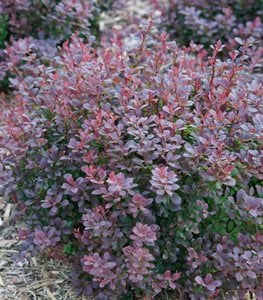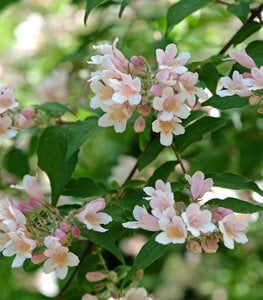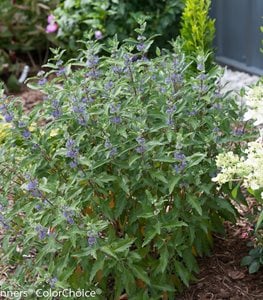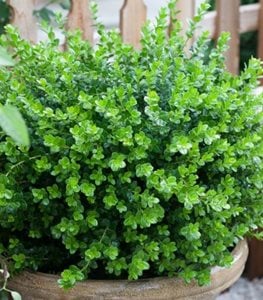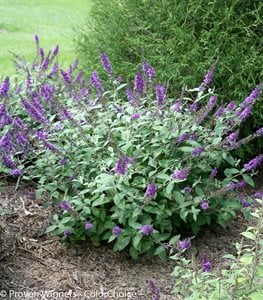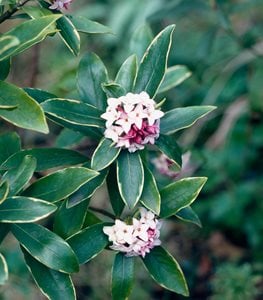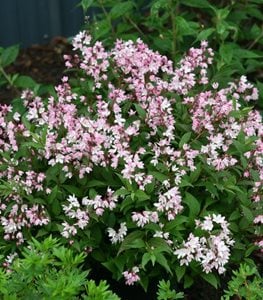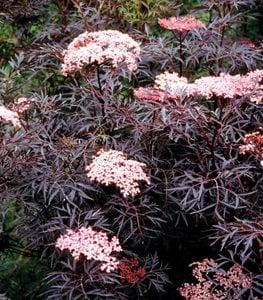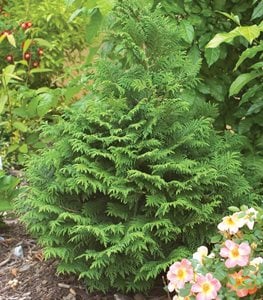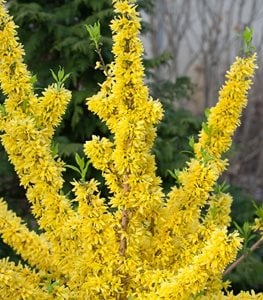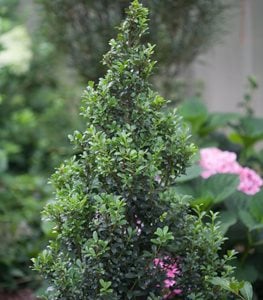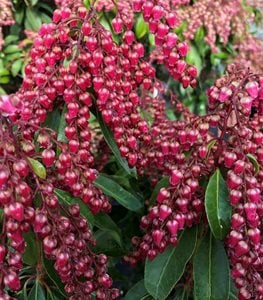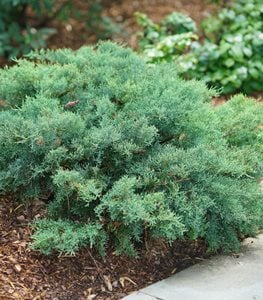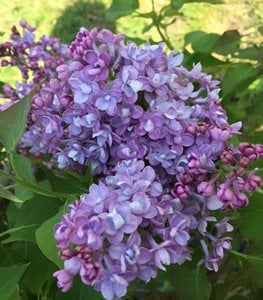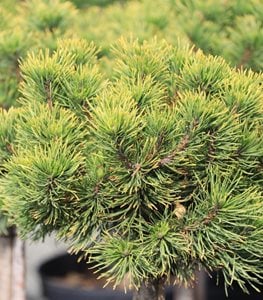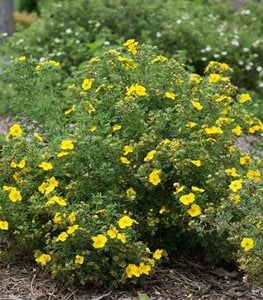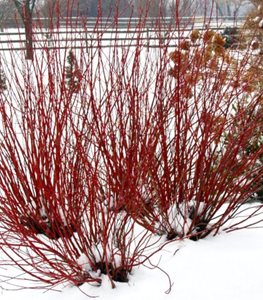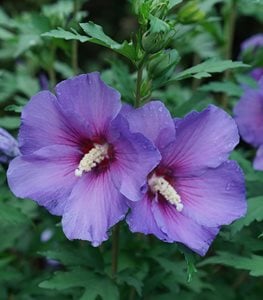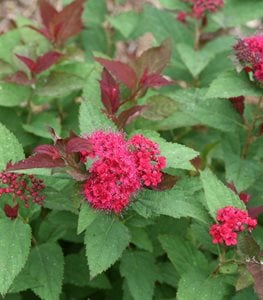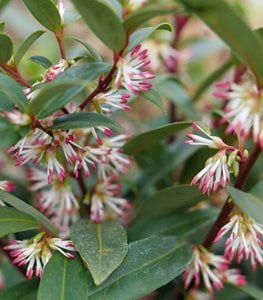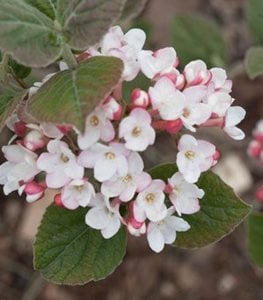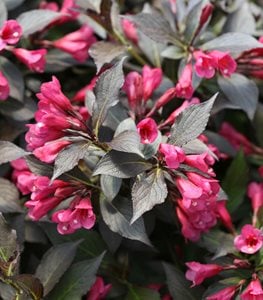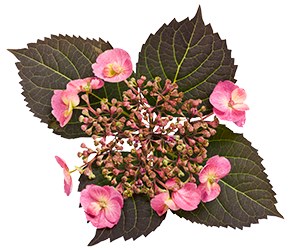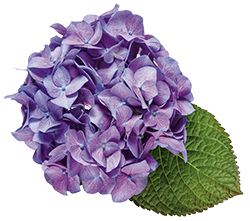Top 25 Deer-Resistant Shrubs to Protect Your Garden
Plant these shrubs in your landscape to reduce damage caused by deerHomeowners who live in suburban and rural areas know the damage that deer can cause to the landscape. A hungry deer herd can quickly decimate a hosta border or strip favorite shrubs bare of their leaves. Deer will nibble on almost any plant if they are hungry enough, especially after a long winter when food sources are scarce. Short of erecting an electric deer fence, which can be cost prohibitive, the easiest solution to deter deer from eating your beloved garden plants is to use deer-resistant plants in your yard.
Some garden plants such as hostas, hydrangeas, and daylilies are more likely to be grazed on by deer. They prefer plants with soft, lettuce-like leaves that are easy to chew and will shun plants with a rough texture, sharp needles, or thorns. Deer have a sensitive smell and taste and avoid plants with fragrant flowers, pungent foliage, or bitter-tasting leaves. By choosing plants with these attributes, you can reduce deer damage to your yard. Though few plants are completely deer proof, there are many plants deer will avoid. Here are some of the best deer-resistant shrubs to plant in your garden.
DEER-RESISTANT SHRUBS
ABELIA (Abelia spp.)
Zones: 4-11, depending on the variety
Exposure: Full sun to part shade
Habit: Mounding bushy habit
Height/Spread: 2 to 10 feet tall, 2 to 8 feet wide
Bloom time: Spring to fall
Abelia is a deciduous shrub with colored or variegated foliage and fragrant long-blooming flowers. Plants are virtually maintenance-free and tolerant of shade, drought, and poor soil. Deer avoid abelia due to the scent of the flowers and bitter-tasting foliage, but may graze on plants if other food sources are scarce. Learn more about growing abelia.
Pictured: Funshine® abelia from Proven Winners.
BARBERRY (Berberis thunbergii and spp.)
Zones: 4-8
Exposure: Full sun to partial shade
Habit: Upright mounding, bushy, or columnar habit
Height/Spread: 2 to 10 feet tall, 2 to 8 feet wide
Bloom time: Spring
This popular deciduous or evergreen shrub produces colorful leaves, berries, and fall foliage for multi-seasonal appeal. Plants are useful as hedging and in mass plantings. The dense growth and sharp thorns are a deterrent to deer. Barberry is invasive in some regions, but newer sterile varieties are available.
Pictured: Sunjoy Todo® sterile barberry from Proven Winners.
BEAUTYBUSH (Kolwitzia amabilis)
Zones: 4-8
Exposure: Full sun to partial shade
Habit: Bushy arching habit
Height/Spread: 6 to 10 feet tall and wide
Bloom time: Spring
Kolwitzia is a deciduous shrub grown for its elegant arching habit, blue-green foliage, and prolific clusters of soft pink flowers in spring. Plants are easy to care for and tolerant of different soils. Use as a background plant, in foundation plantings, or as hedging. Deer tend to leave beautybush alone.
BLUEBEARD (Caryopteris spp.)
Zones: 5-9
Exposure: Full sun
Habit: Mounding bushy habit
Height/Spread: 2 to 4 feet tall and wide
Bloom time: Summer to fall
Bluebeard adds late-season interest to the landscape, with green or gold foliage and feathery flower spikes that occur in summer and fall. Plants are low maintenance and drought tolerant. This petite deciduous shrub is suitable for small spaces, shrub borders, and mass plantings. Deer are repelled by the heavy scent. Learn more about growing bluebeard.
Pictured: Beyond Midnight® bluebeard from Proven Winners.
BOXWOOD (Buxus spp.)
Zones: 5-9, with a few varieties hardy to Zone 4
Exposure: Full sun to shade
Habit: Dense, upright mounding or conical habit
Height/Spread: 1 to 20 feet tall, 2 to 8 feet wide
Bloom time: Spring; flowers are insignificant
This versatile shrub is commonly used as hedging or privacy screening, lending structure to beds and borders. Boxwood foliage is highly amenable to shearing into formal hedges and topiaries. One of the best deer-resistant evergreen shrubs, boxwood contains a toxic alkaloid compound and exudes a pungent scent to deter deer. Learn more about growing boxwood.
Pictured: Sprinter® boxwood from Proven Winners.
BUTTERFLY BUSH (Buddleia spp.)
Zones: 5-9
Exposure: Full sun
Habit: Upright bushy habit
Height/Spread: 3 to 12 feet tall and wide
Bloom time: Summer to early fall
Butterfly bush is a deciduous shrub named for the colorful flower spikes that are highly attractive to butterflies and other insect pollinators. Plants are carefree and drought tolerant. Non-seeding varieties can be grown in areas where butterfly bush is invasive. Deer will avoid butterfly bush due to the fragrant flowers and bitter taste of the leaves. Learn more about growing butterfly bush responsibly.
Pictured: Lo & Behold® 'Blue Chip Jr.' butterfly bush from Proven Winners.
DAPHNE (Daphne spp.)
Zones: 4-9, depending on the variety
Exposure: Partial shade
Habit: Bushy spreading habit
Height/Spread: 1 to 5 feet tall, 2 to 6 feet wide, depending on the variety
Bloom time: Late winter to fall, depending on the variety
Daphne is a broadleaf evergreen shrub with green or variegated foliage and tubular flowers that are intensely fragrant. This small- to medium-sized shrub is useful in borders, foundation plantings, and woodland settings. Deer are repelled by the scent and find the poisonous berries to be distasteful.
DEUTZIA (Deutzia spp.)
Zones: 5-8
Exposure: Full sun to partial shade
Habit: Bushy, upright, or ground cover habit
Height/Spread: 1 to 10 feet tall, 2 to 8 feet wide, depending on the variety
Bloom time: Mid-spring to early summer
One of the best deer-resistant flowering shrubs to grow, deutzia produces textured foliage and fragrant bell-shaped flowers that bloom in spring. This hardy deciduous shrub is useful in foundation plantings and mixed borders, and is virtually maintenance free. Plants are seldom bothered by deer due to the fragrant flowers and unpalatable foliage. Learn more about growing deutzia.
Pictured: Yuki Cherry Blossom® deutzia from Proven Winners.
ELDERBERRY (Sambucus spp.)
Zones: 3-9
Exposure: Full sun to partial shade
Habit: Upright bushy habit
Height/Spread: 3 to 30 feet tall and wide
Bloom time: Spring to summer
Sambucus is a hardy deciduous shrub with attractive foliage, lacy flowers, ornamental berries, and brilliant fall color. Use as hedging or in a woodland border. Deer prefer other plants to elderberry, which are generally considered deer resistant. However, elderberry may be more susceptible to deer browse in certain regions, with some species more resistant than others. Learn more about growing elderberry.
Pictured: Black Lace® elderberry from Proven Winners.
FALSE CYPRESS (Chamaecyparis spp.)
Zones: 3-9, depending on the species
Exposure: Full sun to partial shade
Habit: Upright, mounding, pyramidal, or columnar habit
Height/Spread: 5 to 130 feet tall, 6 to 25 feet wide, depending on the variety
This hardy evergreen conifer produces fine needles that add texture to borders and woodland settings. Garden cultivars are bred for their smaller stature. Deer may graze on false cypress in winter when other food sources are scarce, though they tend to leave plants alone during the growing season. Learn more about growing false cypress.
Pictured: Soft Serve® false cypress from Proven Winners.
FORSYTHIA (Forsythia spp.)
Zones: 3-9
Exposure: Full sun to partial shade
Habit: Upright, bushy, or arching habit
Height/Spread: 1 to 10 feet tall, 3 to 10 feet wide
Bloom time: Early to mid spring
Forsythia is a hardy deciduous shrub grown for the cheerful yellow flowers that appear in early spring. These plants thrive in a wide range of growing conditions. Use these fast-growing, flowering shrubs as hedging or in foundation plantings. Deer avoid forsythia due to the bitter taste of the leaves. Learn more about growing forsythia.
Pictured: Show Off® forsythia from Proven Winners.
HOLLY (Ilex spp.)
Zones: 3-9
Exposure: Full sun to partial shade
Habit: Upright, bushy, or arching habit
Height/Spread: 1 to 10 feet tall, 3 to 10 feet wide
Bloom time: Early to mid spring
Ilexis a diverse group of plants with deciduous or evergreen foliage and colorful berries that provide winter interest. This versatile landscape plant can be used as hedging, in foundation plantings or borders. Some types of holly are more deer resistant than others. Those with thick, spiny leaves tend to be left alone. Winterberry and inkberry are less affected, while blue holly and Japanese holly are more susceptible to deer browse. Learn more about growing holly shrubs.
Pictured: Sky Box® Japanese holly from Proven Winners.
JAPANESE PIERIS (Pieris japonica)
Zones: 5-8
Exposure: Partial sun to partial shade
Habit: Upright bushy habit
Height/Spread: 3 to 12 feet tall, 3 to 8 feet wide, depending on the variety
Bloom time: Late winter to early spring
This broadleaf evergreen shrub adds year-round appeal to the landscape with green or variegated foliage, clusters of bell-shaped flowers and attractive new growth. Use in woodland borders, foundation plantings, and as hedging. Deer are repelled by the scented flowers and bitter taste of the leaves. Learn more about growing pieris shrubs.
Pictured: Interstella® lily of the valley shrub from Proven Winners.
JUNIPER (Juniperus spp.)
Zones: 2-10, depending on the variety
Exposure: Full sun
Habit: Upright, spreading or weeping habit
Height/Spread: 2 to 10 feet tall, 2 to 8 feet wide
Juniperus is a hardy evergreen conifer available in a wide range of sizes, shapes, and colors. This versatile plant adds texture, structure, and background color to borders, rock gardens, slopes, and foundation plantings. Deer are repelled by the pungent scent, bitter taste, and sharpness of the needles. Learn more about growing juniper shrubs.
Pictured: Montana Moss® juniper from Proven Winners.
LILAC (Syringa spp.)
Zones: 2-8
Exposure: Full sun to partial shade
Habit: Upright bushy habit
Height/Spread: 4 to 15 feet tall, 3 to 12 feet wide
Bloom time: Spring; some newer varieties rebloom
This beloved hardy deciduous shrub produces clusters of flowers that add color and fragrance to the spring garden. Grow lilac bushes in foundation plantings, as hedging or screening. Deer avoid lilac due to the scent and bitter taste of the leaves. Learn more about growing lilac bushes.
Pictured: Scentara® Double Blue lilac from Proven Winners.
MAHONIA (Mahonia spp.)
Zones: 5-9
Exposure: Full sun to partial shade
Habit: Upright bushy or creeping habit
Height/Spread: 1 to 10 feet tall, 2 to 8 feet wide
Bloom time: Winter, spring, fall, depending on the variety
Mahonia is a hardy evergreen shrub with holly-like leaves, clusters of bell-shaped flowers and ornamental berries for multi-seasonal appeal. Use this easy-care shrub in foundation plantings or native landscapes. Deer find the thick, spiny texture of the leaves to be unpalatable.
MOUNTAIN LAUREL (Kalmia latifolia)
Zones: 4-9
Exposure: Partial sun or dappled shade
Habit: Upright bushy habit
Height/Spread: 3 to 15 feet tall and wide, depending on the variety
Bloom time: Spring
Kalmia is a broadleaf evergreen, and is one of the few native shrubs that is deer resistant. Plants have an attractive habit and foliage, with showy bell-shaped flowers. Use in a native landscape, foundation planting, or mixed border. Though deer sometimes graze on the flowers, they are repelled by the toxic leaves, which cause a burning sensation when eaten.
MUGO PINE (Pinus mugo)
Zones: 2-7
Exposure: Full sun to partial shade
Habit: Upright spreading habit
Height/Spread: 2 to 5 feet tall, 3 to 6 feet wide
Mugo pine is an elegant evergreen conifer with a dwarf stature suitable for small spaces. The mounding habit and soft needles add year-round color, texture, and structure to rockeries, slopes, and Asian-style gardens. Deer find the sharp spiky needles and resinous oils to be distasteful.
POTENTILLA (Pontentilla spp.)
Zones: 2-8
Exposure: Full sun to partial shade
Habit: Bushy or ground cover habit
Height/Spread: 3 inches to 4 feet tall, 6 inches to 5 feet wide
Bloom time: Spring to fall, depending on the variety
This popular landscape shrub is valued for its carefree nature, long bloom time, and exceptional toughness. Plants produce finely textured foliage and long-blooming, strawberry-like flowers. Use as a ground cover, in mass plantings or borders. Deer avoid potentilla due to the bitter taste and hairy texture of the leaves. Learn more about growing potentilla shrubs.
Pictured: Happy Face® Yellow potentilla from Proven Winners.
RED TWIG DOGWOOD (Cornus sericea)
Zones: 2-8, depending on the species
Exposure: Full sun to partial shade
Habit: Upright spreading habit
Height/Spread: 2 to 15 feet tall and wide
Bloom time: Late spring
Cornus sericea has year-round appeal, with deciduous foliage, spring-blooming flowers, berries, and brightly colored stems that light up the winter landscape. Add to a winter garden or native landscape. Though some dogwoods may be susceptible to deer damage, red twig dogwood is one of the types least affected. Learn more about growing red twig dogwood.
Pictured: Arctic Fire® Red dogwood from Proven Winners.
ROSE OF SHARON (Hibiscus syriacus)
Zones: 5-9
Exposure: Full sun to partial shade
Habit: Upright bushy habit
Height/Spread: 8 to 12 feet tall, 6 to 10 feet wide
Bloom time: Mid-summer to fall
Rose of Sharon lends an exotic tropical appeal to the landscape, with showy trumpet-shaped flowers. This hardy deciduous shrub can be used as hedging, in foundation plantings and borders. Plants produce a sticky sap, with bitter-tasting leaves that deer avoid. Rose of Sharon may experience some deer browse if other food is scarce, but will recover quickly from any damage. Learn more about growing rose of Sharon.
Pictured: Paraplu Violet® Rose of Sharon from Proven Winners.
SPIREA (Spiraea spp.)
Zones: 4-8
Exposure: Full sun to partial shade
Habit: Mounding bushy habit
Height/Spread: 2 to 8 feet tall, 2 to 6 feet wide
Bloom time: Spring to summer
One of the most popular landscape plants for its versatility, Spiraea is a hardy deciduous shrub with green or chartreuse foliage and lacy clusters of flowers in spring and summer. Use as hedging, in mass plantings or mixed borders. Deer avoid spirea for its scent and fuzzy texture. Learn more about growing spirea.
Pictured: Double Play Doozie® spirea from Proven Winners.
SWEET BOX (Sarcococca hookeriana var. humilis)
Zones: 6-9
Exposure: Partial sun to full shade
Habit: Upright bushy habit
Height/Spread: 1 to 6 feet tall, 2 to 6 feet wide
Bloom time: Mid-winter to early spring
Sarococca is a broadleaf evergreen shrub grown for the attractive dark-green foliage and intensely fragrant flowers that add interest to the early-season landscape. Use as hedging, in a shade border or winter garden. Deer are deterred by the scent and leathery foliage.
Pictured: Sweet & Lo™ sweet box from Proven Winners.
VIBURNUM (Viburnum spp.)
Zones: 2-11, depending on the variety
Exposure: Full sun to partial shade
Habit: Upright bushy habit
Height/Spread: 3 to 20 feet tall, 3 to 12 feet wide
Bloom time: Mid to late spring, with some rebloom
Viburnum is a deciduous or evergreen shrub with attractive foliage, flowers, berries, and fall color that adds multi-seasonal interest to the landscape. Use as hedging, screening, in foundation plantings or borders. The fragrance and texture are unappealing to deer. Learn more about growing viburnum.
Pictured: Spice Girl® Korean spice viburnum from Proven Winners.
WEIGELA (Weigela spp.)
Zones: 4-8
Exposure: Full sun to partial shade
Habit: Upright bushy habit
Height/Spread: 1 to 10 feet tall, 2 to 12 feet wide
Bloom time: Mid to late spring, with some rebloom
Weigela is an old-fashioned favorite, with colorful foliage and clusters of fragrant, tubular flowers that bloom in spring. This deciduous shrub is virtually carefree once established, preferring rich, well-drained soil and regular moisture. Deer are repelled by the fragrance and bitter taste of the leaves. Learn more about growing weigela.
Pictured: Spilled Wine® weigela from Proven Winners.
RELATED:
30 Deer-Resistant Perennials
Top Deer-Resistant Plants & Flowers




